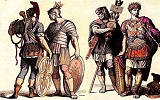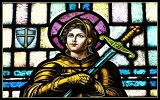|




The
Loire Valley is an area steeped in history and because
of its riches, one that has been fought over and
influenced by a variety of adversaries from by the
Romans to Atila the Hun. The formation of the region as
we know it today began after its conquest by Julius
Caesar in 52BC. It is however Emperor Augustus who is
credited with bringing peace and stability to the Loire
Valley. This stability saw the growth of towns such as
Orleans
(Genabum),Tours
(Caesarodunum), Le Mans
(Noviodunum), Angers
(Juliomagus),Bourges
(Avaricum) and Chartres
(Autricum).Their influence is still evident in these now
fine cities in varying degrees. The Roman's greatest
influence however might be considered to be the
introduction of the first vines to the region.
Christianity spread to the region due, to a large extent, to the work of the
first Bishop of Tours, St. Gatien and in the 4th century was further
accepted throughout Touraine due to the influences of the now much admired,
bishop St. Martin.
After the Huns were repelled at Orleans in 451 the
area was eventually conquered by the Frankish king Clovis in 507 but this didn't
stop the Saracens from the south or Vikings from the north trying to lay claim
to this fertile land.
From then and during the middle
ages (5th to15th century) the foundations were laid for the great political
and religious centres that were to follow. With all the major cities of the
area having a part to play in the formation and destiny of the France we
know today.
Tours was actually a larger city
than Paris at this time with its growth centred around the followers of
Saint Martin. Angers to the west and Blois to the east had feuding, powerful
nobles building fortresses to protect their territories. Many of these were
the responsibility of prolific builder of fortifications, Folk Nerra Count
of Anjou (970-1040) and they would later become the sites of many of
the grand chateaux we see today. Chinon was to become the popular residence
of the Plantagenet kings of England after they had gained the County of
Anjou through marriage during the 11th century. Orleans was home to original
'kings of France' with a dynasty dating back to the 9th century, which would
endure right up to the French revolution. In Vendome we see the rise of the
Bourbon dynasty which would provide future kings of France and Spain.
By the
15th century the country was looking to
unite as a national force but this was
hampered by England's desire to conquer the
whole of France for itself. During what was
to become known as the 'Hundred Years' War'
(although it lasted longer!) most of the
Loire Valley had been captured and in 1429
as Orleans was being besieged it looked like
they would succeed in their desire. What
they didn't expect was a French saviour in
the form of a 17 year old peasant girl from
Domremy in Champagne.
Joan of Arc (Jeanne d'Arc) who
rallied the French army and freed the city
and chased the English from the Loire
Valley. Her reward for this is well
documented (see
here)
but her actions did lead to her canonisation
as St Joan.
The 16th century saw several French kings
fight and for a short time, rule in Italy.
These adventures resulted in a great
Renaissance of French architecture, art and
design. It also saw the French
nobility relocate to the Loire Valley.
Shortly after his Italian patron Giuliano
died in 1516,Leonardo de Vinci was enticed
here by the arts loving Francois I, with the
promise of a pension and comfortable
residence. His and other Italian influences
have left their mark in the form of the
glorious chateau and gardens throughout the
Loire Valley. All their energies were not
however devoted to the pursuit of the arts
and as many of the chateaux stories and
legends will testify, they set
aside much time for
seductions, trysts and rendezvous of an
amorous nature.
In the mid 16th century the war between
Catholics and Protestants (War of Religion), which would last 30 years,
was followed by the plague and these events all but ended this 'golden
age' of Loire Valley history. The French kings retreated back to Paris
and their grand Châteaux became glorious relics of a bygone age.
The 17th and 18th centuries saw the
re-establishment of the Catholic Church. This resulted in an
increase in the number of convents and seminaries and a decline in
the Protestant movement within the Loire Valley. The 17th century
saw the economy of the region thrive with the growth of its
agricultural and textile industries but by the 18 century the
textile industry had become unsustainable due largely to the effects
of the Revolution. The region was split in its support, with the
areas of Maine and Anjou joining the people of the Vendee against
and Touraine and Orleans for the Revolution. Its effects
would be longstanding both materialistically ( it left many ruins)
and physiologically, with bitterness engrained in the psyche of its
people.
The Revolution is often seen as the "dawn of the modern era" and
within France, it was responsible for draining the wealth of the
Church and dismantling the power of the aristocracy. That said, the
two institutions endured despite the damages they sustained. We will
let historians debate the success or otherwise of this historical
event. Its effects on the Loire valley are still visible and indeed
invisible, like the chateau at
Richelieu,
today.
The 19th century wasn't a great time for
the French military what with the fall of the Empire and the
Franco-Prussian War. The armies of the Loire Valley were heavily
involved in protecting the country from invasion by the Prussians
with Orleans again being a key strategic position.
The area also had its parts to play in
the 'Great wars' with the American Expeditionary Force setting up
its headquarters in Tours during the First World War and serving as
a temporary base for the French government before continuing down to
Bordeaux at the beginning of the Second. The town of Montoire near
Vendome was to play an interesting part in the Second World War as
it was here on a train that Hitler met with Marshal
Pétain and agreed to his terms for an armistice
see article here.
This leads
to the country being divided into two zones - the occupied zone
(2/3) and free zone (see
map). The effect on the
people of the Loire Valley was a splitting of the region with all
but the people of Southern Touraine being held within the occupied
zone. This again was a testing time for families and friends split
by a border control not of their own making. It would not be until
September 1944 before the French Resistance and Allied forces retook
the area from the German occupiers.
External links:
https://en.wikipedia.org/wiki
History of France on wikipedia
Back to top.
"Author: Jim
Craig"
|




